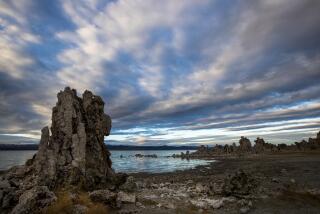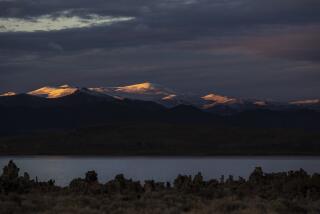Confronting a Mammoth Lack of Water : Sierra Resort Rations a Dwindling Resource
- Share via
MAMMOTH LAKES — Jim Kuykendall uttered a mild expletive as his pickup rounded the bend on the steep winding mountain road and he spotted the sprinklers going full blast at the big condominium complex.
“Wrong hour. Wrong day,” the water company general manager muttered with obvious frustration.
He parked in front of the condo office. But the manager was not there and had to be tracked down by phone. His explanation: He was testing the sprinkler system, not actually watering.
Kuykendall was not satisfied. Water was running over the lawn and into the street.
He posted a notice on the office door:
“This is the third time this condo has irrigated when it isn’t supposed to. Next time it will be a $200 fine. After that, the water could be turned off.”
State’s Toughest Restrictions
Mammoth Lakes is perhaps the driest community in California and the one with the toughest restrictions on water use in the dry summer of 1987.
Due to the extremely low snowpack last winter, water rationing has been in effect all summer at this 7,860-foot resort on the eastern slope of the Sierra.
Lakes in the Mammoth area are lower than normal. Horseshoe Lake is down 20 to 30 feet. Streams are dropping rapidly. There are fears that the trout supply will be endangered.
To conserve the depleting water supply, stringent restrictions are being enforced. Residents may water their lawns and gardens during specified hours three days a week. Planting lawns is prohibited.
Washing down sidewalks, driveways, pool decks and patios is not permitted. Vehicles can be washed only with a pistol-gripped nozzle or with water in a bucket. Water is not to be used on construction projects to keep down dust.
Tables in restaurants have cards that tell diners: “We serve water only on request.” Every motel and hotel room and rental unit has a sign: “Wasting water costs everyone. The High Sierra had very little snow this last winter. Help our community save water.”
The local cable television station runs spots throughout the day urging viewers to conserve water. Water-saving devices are recommended for showers and toilets.
Fine, Water Shut-Off
As indicated by the notice posted by Kuykendall on the condo office door, restrictions can be enforced with $200 fines and water shut-offs. So far, only one fine has been levied and no one has had his water turned off.
The water rationing is paying off. Kuykendall, general manager of the Mammoth County Water District, said 21% less water was used in May and 24% less in June compared to last year’s consumption.
While water officials throughout California are encouraging voluntary conservation--the Los Angeles Department of Water and Power has a $3-million advertising program under way urging water saving--Mammoth is the only place where mandatory restrictions are in place.
The community relies on the lakes for two-thirds of its water supplies and on one town well for the other third.
“It is a lot drier on the east side of the High Sierra than in the rest of the state,” said Bob Potter, 50, deputy director of the state Department of Water Resources. “But we’re getting the word out that all of California could have a serious water problem next year if we have another dry year.”
But restrictions can be especially sensitive in a resort. Mammoth Lakes, with a year-round population of 5,000, plays host to as many as 30,000 visitors on busy summer weekends, most of whom stay in condominiums.
“Most condos are planted with wall-to-wall sod--roll-on lawns--that gobble up 40% of the water used throughout the year, as much as 80% of the water consumed in summer,” explained Kuykendall, 42.
“Condo owners compete for the recreation dollar. The greener the lawns, the more attractive their places, the better chance they have to rent them, so they think. They pour water to the sod,” Kuykendall sighed. “It costs a small fortune to replace the lawns that wither and die.”
Lakes, Streams Affected
The water shortage also affects the lakes and streams that are among the prime tourist draws.
The Mammoth Lakes--Twin, Mamie, Mary and George--still have ample water for recreation. Horseshoe Lake is the only lake dramatically depleted.
“We are trying to maintain the lake levels. Yet at the same time, by law we are required to make sure Mammoth Creek, which flows into Hot Creek, the Owens River and eventually into the Los Angeles Aqueduct, does not dry up,” Kuykendall said.
State fish and game codes mandate that the Mammoth County Water District must release enough water below the dam at Twin Lakes to keep in good condition any native or planted fish.
Dick Dahlgren, 49, Mammoth Lakes realtor and Mono County manager for Cal Trout, a 3,000-member statewide fishing support organization, said the critical period for the fish will be in September and October.
“Mammoth Creek tumbles down the mountain through the town of Mammoth Lakes and becomes Hot Creek after it passes under Highway 395. Hot Creek is the premier trout fishing creek in the West,” Dahlgren explained.
“Our concern is the possibility of losing the . . . wild native trout in late summer if there isn’t enough water in Mammoth Creek or Hot Creek.”
Phil Pister, 58, state fish and game biologist stationed in the area for 30 years, describes Mammoth Lakes as a classic example “of development outstripping the ability of resources to sustain it.”
“This was a sleepy little village in the 1970s. Ever since 1980 one development after another has been constructed in Mammoth Lakes. Build. Build. Build. And still building. In years of low snowpack, water shortages are bound to occur.”
Praying for Rain
Meanwhile Kuykendall and townspeople are praying for rain--unlikely in summer.
“We are trying to get by on 1.2 million gallons of water a day. That will be achieved by drawing Lake Mary down three feet between now and Sept. 15. If we use more than that, we’ll have to institute further water restrictions.”
As for long-term resolutions to the problem, Kuykendall said the water district is exploring with the U.S. Forest Service the possibility of drilling for water in nearby Inyo Forest. There are also discussions with the Los Angeles Department of Water and Power about building a pipeline from Crowley Lake 15 miles east of town.
“There is water nearby. We’re looking at a number of options. We just happen to be high up near the top of the watershed, and in a dry year there’s limited storage to serve the needs of this town,” Kuykendall said.
More to Read
Sign up for Essential California
The most important California stories and recommendations in your inbox every morning.
You may occasionally receive promotional content from the Los Angeles Times.










